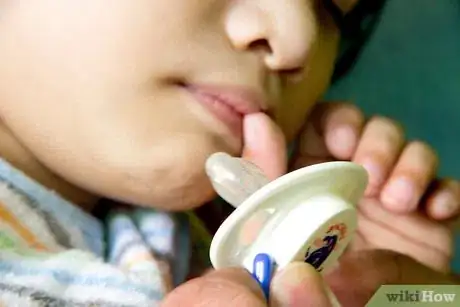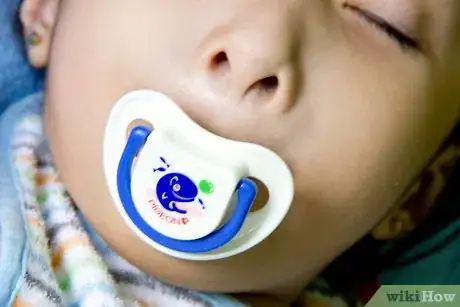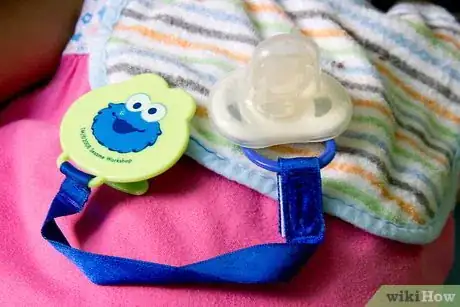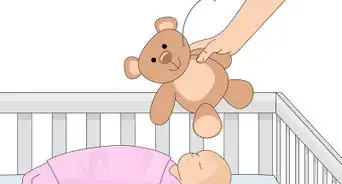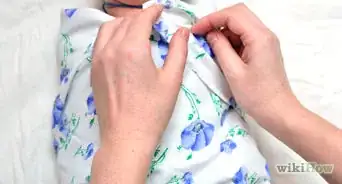wikiHow is a “wiki,” similar to Wikipedia, which means that many of our articles are co-written by multiple authors. To create this article, 23 people, some anonymous, worked to edit and improve it over time.
This article has been viewed 117,419 times.
Learn more...
If you're a parent, you may have heard that pacifiers can be taken away later in life to prevent dental problems, while thumbs cannot. Let's face it though, some babies dislike pacifiers! For many parents, preventing thumb sucking can be quite the battle.
Note that thumb-sucking is not actually a dental problem at the baby stage of development since baby does not yet have teeth! Most children (but not all) grow out of it before their permanent teeth grow in. Also, thumb-sucking is a natural way that some babies self-soothe, which can mean that parents will not have to do as much work to soothe baby. However, if you are worried about your child being unable to break the habit in time here are some helpful tips.
Steps
-
1Wait. If you intend to breastfeed, consider waiting until your baby has gotten used to breast feeding in order to prevent nipple confusion. (For some babies nipple confusion does not occur, so a pacifier can be introduced right away.) Until the pacifier is introduced gently push the baby's hands away from his/her mouth whenever he/she seems likely to want to suck on them. If hunger seems to be the reason for sucking hands, feeding time can be a good way to prevent sucking. It may also help to use baby mittens or baby outfits with sleeves that can be folded over your baby's hands to cover them.
-
2Slowly introduce a pacifier to see how your baby reacts. A wonderful time to introduce a pacifier is when he/she is about to fall asleep while eating. This is because you will have three things working for you: the baby is in a good mood, he/she still feels like sucking, and he/she is sleepy and therefore easily movable and receptive.
- Be careful to avoid doing anything that would make it a bad first experience. Try to avoid forcing an uninterested, hungry, or irritable baby to take the pacifier, because this could make baby angry, thus making baby dislike the pacifier. Also try to avoid pushing the pacifier in too quickly, or at a slightly wrong angle, because this could gag your baby, also making baby dislike the pacifier. (If you have already accidentally done something to make baby hate the pacifier, no worries – you can still do this!)
Advertisement -
3If baby responds positively to the pacifier, go ahead and skip to the next step, otherwise, if baby seems uninterested or dislikes the pacifier, try these suggestions:
- First, if your baby starts to take the pacifier but then spits it out, try gently tugging on it when it is in your baby's mouth. This triggers the baby's reflex to suck it back in. Be careful not to accidentally push on it while it is in your baby's mouth, because that triggers an opposite reflex causing your baby to spit it out.
- If this trick does not get your baby to take the pacifier, try giving your baby the pacifier later when your baby is in a different mood. Do this a few times to try to find the best mood to introduce it.
- If that still does not work, consider testing out pacifiers of a different size or shape. For some babies (especially newborns) the standard pacifier has a nipple that is too large and can make them gag. There are special newborn and premature size pacifiers that may work better.
- If all else fails, as a last resort put something sweet on the pacifier, such as fruit preserves or sugar water. Sure, this is not preferable, but realistically some babies just refuse to take a pacifier until it is introduced this way. Keep gently introducing the pacifier until baby shows an interest in sucking on it. (This may take as long as a week or two. Don't give up! If you stick to it, it will happen eventually.)
-
4Now that baby is interested in the pacifier, keep a pacifier handy and offer it each and every time your baby starts to go for his/her thumb or hands. It may be helpful to buy a pacifier clip to attach the pacifier to the baby's clothes. (It is best to choose one with a short strap so that strangulation is not a risk.) Alternatively, you could always carry a pacifier with you in your pocket, diaper bag, or clipped to your clothes.
- Another option is to buy lots of pacifiers and keep one in each place that you might set the baby to rest (for example, one by the crib, one by the baby swing, one in the car glove compartment for car trips).
Community Q&A
-
QuestionHow do I stimulate a baby visually?
 Community AnswerUse toys with bright (safe) lights and bright colors.
Community AnswerUse toys with bright (safe) lights and bright colors.
Warnings
- Do not give up! You will probably get discouraged, even down-right angry at some point. That is normal. Stick to it. You can do this.⧼thumbs_response⧽
- Remember never to force the pacifier! That will just turn things into an out-and-out battle! (Do not worry if this has already happened. Just keep following the advice in this article and your baby will eventually take a pacifier.)⧼thumbs_response⧽
Things You'll Need
- Pacifier(s) – bright colors tempt babies; and always have a few as they're easy to lose. Make sure the pacifiers are dishwasher-proof; it's the best way to get them properly clean.
- Something sweet to tempt baby
References
- http://answers.yahoo.com/question/index?qid=20060906131742AAAaS4S – research source

